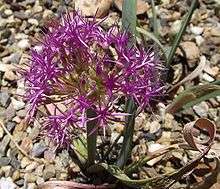Allium platycaule
| flat-stem onion | |
|---|---|
 | |
| Scientific classification | |
| Kingdom: | Plantae |
| Clade: | Angiosperms |
| Clade: | Monocots |
| Order: | Asparagales |
| Family: | Amaryllidaceae |
| Subfamily: | Allioideae |
| Tribe: | Allieae |
| Genus: | Allium |
| Species: | A. platycaule |
| Binomial name | |
| Allium platycaule S.Wats. | |
Allium platycaule is a species of wild onion known by the common name broadstemmed onion or flat-stem onion. It is native to northeastern California, south-central Oregon (Lake County) and northwestern Nevada (Washoe and Humboldt Counties). It is found on slopes of elevations of 1500–2500 m.[1]
Allium platycaule grows from a gray bulb two to three centimeters wide. Scape is thin and strongly flattened, up to 25 cm long but rarely more than 7 mm across. It may be thicker along the midrib and much narrower along the sides. The long, flat leaves are sickle-shaped. Atop the stem is an umbel which may have as many as 90 flowers in it. Each flower may be up to a centimeter and a half wide but the tepals are quite narrow so as to be almost threadlike. The inflorescence therefore may appear be a dense ball of filaments. The flowers are generally bright pink to magenta with yellow anthers.[2][3][4][5]
Uses
The leaves, bulbs, and seeds were utilized as food by the Paiute people.[6]
References
- ↑ USDA Plants Profile
- ↑ Jepson Manual Treatment
- ↑ Photo gallery
- ↑ Watson, Sereno. 1879. Proceedings of the American Academy of Arts and Sciences 14: 234.
- ↑ Hickman, J. C. 1993. The Jepson Manual: Higher Plants of California 1–1400. University of California Press, Berkeley.
- ↑ Ethnobotany
.jpg)